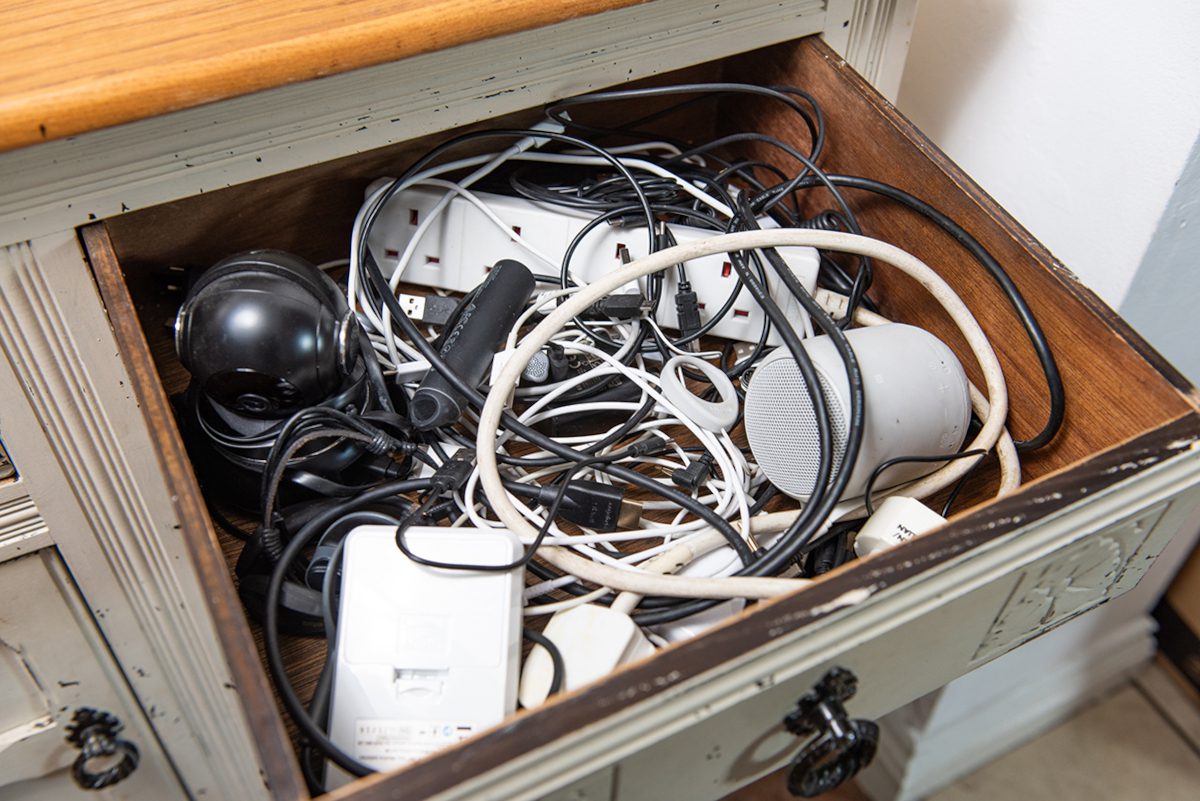
Around £266 million of copper resides in the UK’s unused or binned electricals,1 says charity group Recycle Your Electricals, citing “drawers of doom” that “groan with stashed tech”.
New research from the group appears to reveal that the UK’s 1.3 billion unused or binned electricals, including 627m cables, could hold the answer to the nation’s fast approaching gap in the supply of copper to meet growing demand.2
The recycling charity draws attention to new analysis from Bloomberg Intelligence showing a growing gap between the amount of copper produced and demand for the raw product – globally there will be a 6.5 million tonnes gap by 2033. The same report identifies that better recycling of copper could potentially meet the additional demand.3
Recycle your Electricals research seems to show that UK households contain 38,449 tonnes of copper hidden inside unwanted and thrown away electricals – and according to Bloomberg Intelligence analysis, this is enough to fulfil the UK’s annual demand for copper contained in tech.4
The 38, 449 tonnes inside unwanted and thrown away electricals is the equivalent of 1,240 copper Statues of Liberty.5
Royal Society of Chemistry has found that 347,000 tonnes of copper will be needed to build wind turbines and solar panels by 2030. Recycle Your Electricals says it has identified that 30% of this copper could be produced from recycled copper that is currently thrown away.6
The 627m binned or unused cables are enough to go to the moon and back and contain 3,252 tonnes of copper.7, 8
To mark this year’s International E-Waste Day, Recycle Your Electricals is launching ‘The Great Cable Challenge’ – calling on households, local authorities, retailers, schools and community projects across the UK to take part in the challenge and collectively recycle 1 million cables, helping to reduce e-waste.
With copper becoming more scarce, demand soaring, and the detrimental environmental and social impacts of mining for raw materials – how can the UK help? The solution is surprisingly simple; harness what we have.
Recycle Your Electricals says it has shown that there are 823m unused or broken tech items hiding in UK homes.9 “We’ve all got our own version of a ‘drawer of doom’ – a box, a bag under the bed, or a pile forgotten about in the loft,” says the group, “but these electricals and cables, plus those that have already been thrown away, contain a staggering £266m worth of copper, enough to provide 30% of the copper needed in our green future.”10, 11
Cables represent one of the UK’s biggest e-waste challenges – and one of the biggest copper opportunities as UK households are throwing away or holding onto on average 23 cables.12 Research by the Critical Minerals Association has identified that cables contain at least 20% of copper – which means that across all UK households, we could extract an incredible 3,252 tonnes of copper in cables.13 A step-change is needed. If consumers understood the value of the precious materials inside their unwanted electricals, they wouldn’t be as likely to hold onto items instead of recycling them: 44% of survey respondents said they didn’t know copper is the most commonly used metal in electrical cables.14
A new report from Bloomberg has also outlined how our growing consumption of copper is outstripping the amount produced. Bloomberg intelligence found that during 2023:
- UK “consumed” 250,000 – 280,000 tonnes of copper across a variety of end-uses spanning from infrastructure projects such as wind farms, passenger vehicles to electrical goods15
- About 50,000 – 60,000 tonnes was consumed in the automotive sector in 202316
- Consumer durables such as washing machines, electrical goods and electronics accounted for about 35,000 – 45,000 tonnes of copper consumed17
- The 23,000 tonnes of copper contained in old electrical items could supply a large proportion of the UK’s demand in new consumer durables – almost a perfect circular economy. If the additional 16,000 tonnes that ends up in landfill each year, that would be enough to deliver a fifth of the UK’s annual demand18
However, Grant Sporre, Senior Analyst, Metals and Mining at Bloomberg Intelligence says we need to do more: “Supplying the world’s copper requirements over the next 10 years is going to be challenging, with the market potentially facing severe shortages in five to ten years. All the shallow, easy-to-extract copper deposits have been mined out. Securing social and environmental approval to build new mines is becoming harder, and it can take up to 15 years to commence mining. This, together with the growing demand for copper and the drive to decarbonise, is going to require a significant amount more copper. The building of renewable power generation in the form of wind and solar farms, and the switch from petrol and diesel cars to electric, could keep copper demand growing at 2.5 to 3% per annum. Therefore the gap between supply and demand could grow to as much as 6.5 million tonnes globally by 2033. Better recycling practices and efficiencies will be needed to close this gap. Increasing the proportion of recycled copper to 50% from current levels of 30% would be a significant challenge for global supply chains but could potentially meet the additional demand.”
Scott Butler, Executive Director of Recycle Your Electricals, calls on us to clear out our ‘drawers of doom’ this October. “Fess up time everyone – we all have our own stashes of unused or broken electricals. But it’s time that we realised the value and power of the silent majority; the hidden treasures inside our homes. We need to start ‘urban mining’ and help protect the planet and nature from the harmful impacts of mining for raw materials and instead value and use what we have already. People may not realise that cables and electricals contain valuable materials, not just copper, and that if binned or stashed, we lose everything inside of them when we don’t recycle them into something new. That’s why we’re starting with the Great Cable Challenge. Doing the right thing by your old and unwanted electricals has never been easier; with over 26,000 recycling points around the UK. Just check our Recycling Locator for yours – anything with a plug, battery or cable can be reused and recycled and there’s somewhere near you to do it.”
The Royal Society of Chemistry (RSC) supports this forward thinking. Izzi Monk, RSC Policy Adviser for the Environment, implores people to look to the future and do what they can. “The UK needs to wake up to just how important copper is in achieving our greener future – our analysis suggests we need a significant investment of around 350,000 tonnes for wind and solar power generation by 2030. We are potentially facing imminent and substantial supply concerns where we won’t be able to meet the global demand for this vital material. That’s why we’re calling for the government to commit to a strategic, joined-up approach to materials that considers these supply risks.
”Upping secondary sourcing of copper through recycling is a really important route towards greater supply security – the government needs to invest in technologies and infrastructure to make sure recycling can be grown without creating worse environmental, social and health impacts. As a nation, if we can crack the formula for recycling the copper we already have, we can make a real difference for the future of our planet.”
Making an individual contribution to solving the challenges of e-waste has never been easier. In celebration of International E-Waste Day, Recycle Your Electricals is launching ‘The Great Cable Challenge’ – a nationwide campaign aimed at tackling the millions of cables sitting idle across UK households. It is calling on households, local authorities, retailers, schools and community projects across the UK to take part in the challenge and collectively recycle 1 million cables, helping to reduce e-waste. For more information, visit www.recycleyourelectricals.org.uk/international-e-waste-day-2024/.
Copper and other precious materials are lost forever when electricals are thrown away, but they are essential to the running of our everyday lives, including our phones, transport, medical equipment and critically, our green energy future.
With millions of cables cluttering up UK homes, Recycle Your Electricals have published a handy Cable Guide. With 35 of the most used cables featured, the guide provides easy to use visuals to match cables to their original electricals. If the electricals or the cables are no longer working or they aren’t needed anymore then bag them and recycle them! You can view the cable match guide here.
Good news alert: more of us are recycling than ever with 64% of Recycle Your Electricals’ survey respondents said they recycled electricals through a recycling centre, an electrical recycling bring bank, through a retailer or through kerbside recycling. 19 The valuable materials contained in any electrical item can have a second life through donation, or by being recycled into new items with a surprising range of uses, such as wind turbines, life-saving medical devices or even children’s playground equipment and electric vehicles.
International E-Waste Day (IEWD) 2024 takes place on 14th October. The day aims to engage individuals, retailers, local authorities, businesses and communities to participate in this year’s campaign by encouraging everyone to recycle their electricals.
Notes
[1] Copper tonnage and value research – analysis undertaken by Material Focus.
[2] Research conducted by Opinium for Material Focus between 23rd – 26th July 2024 amongst a nationally-representative sample of 4,000 UK adults.
[3] Future of Copper Consumption Report from Material Focus, featuring Bloomberg Intelligence and Royal Society of Chemistry, September 2024.
[4] Copper tonnage and value research – analysis undertaken by Material Focus.
[5] Copper tonnage and value research – analysis undertaken by Material Focus.
[6]
Future of Copper Consumption Report from Material Focus, featuring Bloomberg Intelligence and Royal Society of Chemistry, September 2024.
[7] Research conducted by Opinium for Material Focus between 23rd – 26th July 2024 amongst a nationally-representative sample of 4,000 UK adults.
[8] Copper tonnage and value research – analysis undertaken by Material Focus.
[9] Research conducted by Opinium for Material Focus between 23rd – 26th July 2024 amongst a nationally-representative sample of 4,000 UK adults.
[10] Research conducted by Opinium for Material Focus between 23rd – 26th July 2024 amongst a nationally-representative sample of 4,000 UK adults.
[11] Copper tonnage and value research – analysis undertaken by Material Focus.
[12] Research conducted by Opinium for Material Focus between 23rd – 26th July 2024 amongst a nationally-representative sample of 4,000 UK adults.
[13] Copper tonnage and value research – analysis undertaken by Material Focus.
[14] Research conducted by Opinium for Material Focus between 23rd – 26th July 2024 amongst a nationally-representative sample of 4,000 UK adults.
[15] Future of Copper Consumption Report from Material Focus, featuring Bloomberg Intelligence and Royal Society of Chemistry, September 2024.
[16] Future of Copper Consumption Report from Material Focus, featuring Bloomberg Intelligence and Royal Society of Chemistry, September 2024.
[17] Future of Copper Consumption Report from Material Focus, featuring Bloomberg Intelligence and Royal Society of Chemistry, September 2024.
[18] Future of Copper Consumption Report from Material Focus, featuring Bloomberg Intelligence and Royal Society of Chemistry, September 2024.
[19] Research conducted by Opinium for Material Focus between 23rd – 26th July 2024 amongst a nationally-representative sample of 4,000 UK adults.






